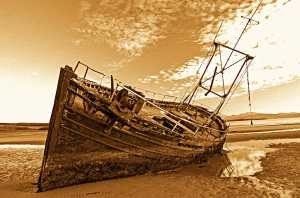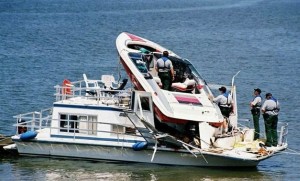Knowing the Difference is Crucial to the Claims Handling Process
 After a number of years appraising insurance claims as a marine surveyor, and a stint as a licensed staff adjuster with a major insurance company, it became obvious to me that sometimes surveyors get confused as to what their job is. I also realized that sometimes the adjuster asks the wrong questions, or gives the wrong instructions. So what are the job descriptions and responsibilities of the adjuster vs. the marine surveyor? I would like to point out that no two insurance companies policies are written the same, and claims handling procedures also differ between the various insurance carriers. Coverage, exclusions, and settlement clauses frequently differ between carriers. Because of these differences it is important that the marine surveyor knows where his or her job starts and stops. For the purpose of this discussion we are talking about first party property claims.
After a number of years appraising insurance claims as a marine surveyor, and a stint as a licensed staff adjuster with a major insurance company, it became obvious to me that sometimes surveyors get confused as to what their job is. I also realized that sometimes the adjuster asks the wrong questions, or gives the wrong instructions. So what are the job descriptions and responsibilities of the adjuster vs. the marine surveyor? I would like to point out that no two insurance companies policies are written the same, and claims handling procedures also differ between the various insurance carriers. Coverage, exclusions, and settlement clauses frequently differ between carriers. Because of these differences it is important that the marine surveyor knows where his or her job starts and stops. For the purpose of this discussion we are talking about first party property claims.
The Marine Loss Adjusters Job Description
When the claim is initiated by the insured it is assigned to an in-house adjuster. The adjuster is provided with the facts of the loss as they were reported to the company. The adjuster also receives a copy of the policy declarations page, which lists the policy owner, identification of the insured property, the coverage, policy dates, deductibles, navigation limits, lay-up periods, premium amounts, lien holder information, etc. The declaration page will also list any endorsements or special coverage that modify the policy.
In the case of companies that offer different types of marine policies, the adjuster will be advised of the type of policy purchased. This could be an actual cash value (ACV) policy, or it could be an agreed value or stated value policy. In a first party property loss, an adjuster typically will follow a chain of events similar to the following.
- Receive the notice of loss, including a brief statement concerning the type of loss and the information reported by the insured.
- Receive confirmation of coverage from underwriting.
- The adjuster will make the initial contact with the insured and to discuss the circumstances of the loss. He or she will explain coverage as well as the terms and conditions of a policy to the insured and may also explain the claim investigation process. In some cases the adjuster may need to take a statement, either written or recorded, from the insured or a witness. If fraud is suspected, the adjuster may have the insured submit to an examination under oath. An attorney normally performs this. Determining that a statement under oath is necessary may come later in the investigative process.
- Request copies of repair estimates, if available. Speak with repair shop(s) to ascertain the scope of the loss, and probable cause of the loss. Determine if a physical inspection is necessary. If the adjuster determines that the cause of the loss or the scope of repairs involve significant damage or are questionable then he or she may either make an inspection, or assign a field investigator or marine surveyor to make an inspection.
- After the adjuster reviews the repair estimates and the findings of the field inspection, the next step is to determine if it is a covered loss. If it is, the terms and conditions of the policy will be applied to arrive at a settlement amount. This amount could be the agreed repair costs less the policy deductible, or if the policy is subject to depreciation, the adjuster will compute the amount payable to the assured.
- The next step would be to write a settlement letter, and or make a phone call to explain to the assured what the payment covers, items, if any, that are being disallowed; and any depreciation that is being taken for wear and tear. If the loss is being denied, the adjuster will write a letter explaining why it was not covered.
- Issue payment and close the file.
The Role of The Marine Surveyor 
When a loss inspection is going to be assigned to a marine surveyor, the adjuster will either call the surveyor to discuss the facts of the loss followed up by a written assignment or the assignment may simply be faxed to the surveyor. The surveyor should review the information and determine if it includes everything that will be necessary to perform the damage appraisal. The adjuster should have defined the scope of the inspection and instructed the surveyor as to what he or she is expected to do. In some cases, the surveyor may be told not to do certain things. A good example would be an instruction to the surveyor that they should not comment on coverage questions, but rather refer those types of questions hack to the adjuster.
In a first party property loss, a marine surveyor typically will follow a chain of events similar to the following:
- Confirm receipt of the assignment back to the adjuster. Read the assignment carefully. Make sure you understand what you are being asked to do and not to do. Taking it upon yourself to go beyond the scope of the assignment may prejudice the claim and could cause the insurance company to pay a claim that it otherwise would not have paid. You should ask questions of the adjuster about anything that may not be clear in the assignment instructions. Know your limitations! Make sure that the assignment is something that falls within your level of expertise. Do not accept an assignment that you are not qualified to handle. Let me repeat, DO NOT accept assignments that you are not qualified to handle, You can quickly get in over your head and jeopardize the claim itself as well as your reputation. Unless you have a well established reputation with the insurance company, all it takes is one blown assignment to move you to the bottom of the list of surveyors in your area who are likely to be contacted to do claims work
- Contact the insured and or the repair shop. Identify yourself, and your role in the investigation. Make sure that all parties understand you are appraising the loss and that you are not the adjuster. Determine the property’s location and make sure it is ready for inspection. Ask questions. Has sufficient tear down been performed to allow a complete inspection of the damage? The surveyor may ask additional questions of the insured about the facts leading up to the loss, and the extent of the damage. The surveyor may also invite the insured to be present during the inspection. Do not address policy coverage or exclusions. Even a casual comment by the marine surveyor concerning what is or is not covered could prejudice the claim and cause the insurance company to pay what otherwise would be a non-covered loss.
- In some cases, the adjuster may have requested that the surveyor take written or recorded statements from the insured or a witness. This part can be a little touchy. Taking a statement may be construed as acting as an adjuster. In 14 states, this may require an adjuster’s license. As a surveyor, it should be incumbent on you to know the local requirements. If you are operating in a state that requires adjusters to be licensed, be careful not to step over the line.
- Inspect and photograph the reported damage. Verify the HIN and make sure that you are inspecting the insured vessel. Note the general condition of the boat; this will help the adjuster if depreciation applies. Take lots of photographs, starting with the boat itself and then working down to the damaged areas. You can’t take too many photos. Even if all of them aren’t used, the extras may come in handy when you’re writing the report. Discuss the damage with the repair facility and get their thoughts on the cause of loss. Consider all of the reported facts as you review the damage. Does the evidence support the story? Or, does the evidence show that the reported cause of loss is suspect? In the case of drive train damage, for example, look at all of the parts. If the damage was reported to be the result of impact, look for a trail of damage from the likely point of impact all the way to the last damaged part. Document the condition of the drive train parts, good or bad. Determine if further investigation by a laboratory is required. Give an early status report to the adjuster. In some cases it may be necessary to take possession of damaged parts for laboratory testing. You must have permission of the owner to do this, and you must document the chain of custody with properly executed transmittal letters. If this isn’t performed correctly, the evidence may not be admissible, should the claim be litigated.
- Prepare your written report. Be timely; there are legal time constraints on your work. Be concise, and report only facts. Be specific; report only on those items assigned by the adjuster and refrain from expanding your role past what was requested. Do not report second or third party information as fact, unless you can prove it beyond doubt with your own investigation. Do not report anything that you cannot back up in a courtroom confrontation with another expert. Do not make statements that could he construed as making policy determinations in your report. Identify other people who made statements to you concerning information that you used to make your determination. State any limitations of your inspection that could reveal additional information. Make sure the report reads well and isn’t laced with spelling errors (spell check!).
 The role of the marine surveyor is critical in the claims decision process. You can make the adjuster’s job easier or you can make it more complicated. Your job is to provide expert opinions that can be used to back up the adjuster’s determination of coverage decisions. Be careful what is included in your written report. While claims rarely reach the courtroom, many become contentious and what you said or didn’t say is likely to be examined closely by the insurance company and their attorneys. Be certain you can back up your opinion with facts.
The role of the marine surveyor is critical in the claims decision process. You can make the adjuster’s job easier or you can make it more complicated. Your job is to provide expert opinions that can be used to back up the adjuster’s determination of coverage decisions. Be careful what is included in your written report. While claims rarely reach the courtroom, many become contentious and what you said or didn’t say is likely to be examined closely by the insurance company and their attorneys. Be certain you can back up your opinion with facts.
Written by: Thomas C. Benton, AMS®, CMS, CMI
Marine Damage Consultants, LLC
P.O. Box 627 Ketchum,
Oklahoma, 74349
Office: (918) 782-1001, Mobile: (918) 519-1972 – Fax: (918) 782-1004
Email: Benton@marinedamageconsultants.com




